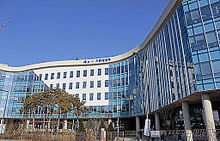Ministry of Economy and Finance (South Korea)
The Ministry of Economy and Finance (MOEF; Korean: 기획재정부; Hanja: 企劃財政部) oversees the financial policies of the South Korean government. It publishes a monthly report on the national economy, known as the "Green Book."[1] The current minister is Choi San-mok. The headquarters is in the Sejong Government Complex in Sejong City.[2]
| 기획재정부 企劃財政部 Gihoek Jaejeong-bu | |
 | |
 MOEF headquarters in Sejong | |
| Agency overview | |
|---|---|
| Formed | February 29, 2008 |
| Preceding agencies |
|
| Jurisdiction | Government of South Korea |
| Headquarters | Government Complex-Sejong, 477, Galmae-ro, Sejong-si 30109, South Korea |
| Minister responsible |
|
| Deputy Ministers responsible |
|
| Child agencies | |
| Website | english |
According to Chapter 3 Article 19 of the Government Organisation Act, the Minister of Economy and Finance also acts as the Deputy Prime Minister, together with the Minister for Education.[3]
MOEF has enforcement functions as well. It oversees the National Tax Tribunal and the Financial Intelligence Unit.
The ministry was formed in 1994 through the merger of the old Economic Planning Board (est. 1961) and Ministry of Finance (est. 1948).
History
edit1948
Three years after gaining independence from Japan, the Korean government was set up and it established the Ministry of Finance and the Economic Planning Board. The Ministry of Finance took charge of designing tax, financial and monetary policies as well as managing state-owned property and exchange rates. On the other hand, the Economic Planning Board was empowered in 1961 and assumed an important mandate of designing 5 year economic development plans in addition to its usual functions such as managing the government's budget and securing foreign loans.
1967
The Economic Planning Board introduces the Republic of Korea's first electronic mainframe computer, an IBM 1401 system, to process data collected from the country's national census conducted the previous year.[4][5]
1994
As the need arose for an integrated approach to implement the government's functions on economic affairs in an efficient and coherent way, the Economic Planning Board and the Ministry of Finance was merged into the Ministry of Finance and Economy (MOFE).[6]
1998
In a response to the 1997 Asian financial crisis, the MOFE's functions were separated and transferred to other Ministries so as to mitigate the overconcentration of decision-making authority by MOFE. Its budgetary authority was transferred to the National Budget Administration, its financial supervision authority to the Financial Supervisory Commission, and its trade negotiating authority to the Ministry of Foreign Affairs and Trade.
1999
The Planning and Budget Commission and the National Budget Administration was merged into the Ministry of Planning and Budget (MPB).
2008
The Ministry of Finance and Economy (MOFE) and the Ministry of Planning and Budget (MPB) were again merged into the Ministry of Strategy and Finance (MOSF) in order to put under one roof fiscal policy functions and inter-ministerial policy coordination. On the other hand, the MOFE's authority on financial policies regarding the financial market was transferred to the Financial Services Commission. In 2018, the ministry changed its official English name to the Ministry of Economy and Finance.
Offices
editCurrently this Ministry is in Sejong Government Complex in Sejong City. Previously the office had its headquarters in the Government Complex Gwacheon, in Gwacheon, Gyeonggi Province.[7]
Tasks
edit1. Planning and coordination of the mid- to long-term socio-economic development goals and setting economic policy direction on an annual basis
2. Distributing resources effectively and assessing the effectiveness of budget execution
3. Planning/reforming Korea's tax policy and system
4. Planning and management of policies for treasury, government properties, government accounting and the national debt
5. Coordination of policies for foreign currency transactions and international finance
6. Enhancement of international cooperation and promotion of inter-Korean economic exchanges and cooperation
7. Management and monitoring of public institutions' operation
Criticism
editThe Ministry of Economy and Finance was accused of releasing a comprehensive review on welfare-related campaign promises of each political party before the 2012 election.[8]
List of ministers
editSee also
editReferences
edit- ^ "Welcome to Ministry of Finance and Economy". Archived from the original on 2006-10-07. Retrieved 2006-04-06.
- ^ "Location." (Archive) Ministry of Strategy and Finance. Retrieved on December 31, 2013. "Ministry of Strategy and Finance, Government Complex-Sejong, 477, Galmae-ro, Sejong Special Self-Governing City 339-012, Korea"
- ^ "Statutes of the Republic of Korea". elaw.klri.re.kr. Retrieved 2022-12-09.
- ^ https://www.ibm.com/ibm/history/ibm100/us/en/icons/mainframe/transform/ [bare URL]
- ^ 서현진. (1997). 처음쓰는 한국컴퓨터사 (서울: 전자신문사).
- ^ Jung, J.-Y. (2011). How a Powerful Bureaucracy Fell: The Abolition of the Economic Planning Board in South Korea. Korea Observer. 42. 551-581.
- ^ "Location" (English) (). Ministry of Strategy and Finance. April 9, 2011. Retrieved on December 31, 2013. "Ministry of Strategy and Finance, Government Complex II, 49 Gwanmoonro, Gwacheon City, Gyeonggi Province, 427-725, Korea"
- ^ "Finance Ministry Accused of Violating Election Rules". KBS. 2012-04-05. Retrieved 2012-05-06.
External links
edit- Official English site
- Official site (in Korean)